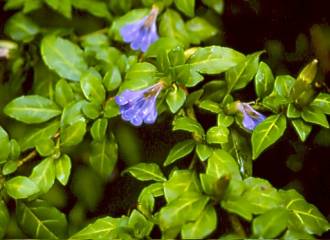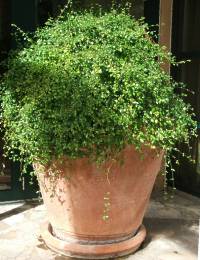Sclerochiton harveyanus
Sclerochiton harveyanus Nees
Family: Acanthaceae
Common names: blue lips (Eng.); blou-lippe (Afr.); mazabuka (Swati); isiThibothi (Xhosa)
SA Tree No: 681.4
Introduction
Unusually lipped, mauve-blue flowers create a pretty floral display on this shade-loving shrub with its attractive glossy green foliage.

Description
Description
The multi-stemmed rounded spread of this lovely shrub generally reaches 3 x 3 m, occasionally growing to a small tree at 4 m high.

Its branches are soft-wooded, thin and lax, and will occasionally scramble into neighbouring vegetation. Foliage is glossy deep-green above and dull-green on the underside. Small delicate leaves are oval to elliptic, measuring approximately 50 x 25 mm, opposite on 5-mm long stalks. Leaf margins are bluntly and irregularly toothed.
Flowers appear during summer (Dec.-Mar.) and are solitary, borne on stem tips. Flowers are mauve-blue to purple and the lower petals are ribbed, giving the impression of lips, hence the common name `blue lips'. Five fringed lobes, equal in size, short and rounded, are the flowers' distinguishing feature. All Sclerochiton species will produce either white, blue or purple flowers or a combination of the three. After flowering, a green fruiting capsule with a tapering tip emerges.
Conservation Status
Status
Sclerochiton harveyanus appears on the 2009 Red List with the status of Least Concern and is under no threat.
Distribution and habitat
Distribution description
Occurs on margins of evergreen forest or as part of the forest understorey from Eastern Cape to Zimbabwe. It can be found at altitudes of 90-1700 m. S. harveyanus is much more widespread than other species of the genus, covering areas such as Limpopo, Mpumalanga, Swaziland, KwaZulu-Natal and Eastern Cape.
Derivation of name and historical aspects
History
The genus name is from the Greek skleros = hard and chiton = covering, referring to the woody casing of its fruiting capsule. The species epitjet harveyanus is after Dr William H. Harvey 1811-66 who was Treasurer General of the Cape Colony and author of the early volumes of Flora capensis and later Professor of Botany in Dublin.
Sclerochiton was described by Harvey in the London Journal of Botany 1: 27 (1842), however no species were ascribed to that genus at that time. In 1887, Nees referred S. harveyanus to the genus. Today a total of 19 species is recognized.
Like other Acanthaceae genera, Sclerochiton can be identified by opposite leaves and irregular, bisexual flowers with a total of four stamens which can be seen emerging from the corolla.
Ecology
Ecology
The numerous flowers produced in summer are attractive to pollinating insects which encourage insect-feeding birds into the garden. The wide distribution of S. haveyanus could be attributed to the dispersal of its seed. On ripening, each capsule splits into two valves, explosively ejecting the seed. The fast-rooting nature of new shoots and runners is further explanation of the species' success in the wild. Seeds, which are one of the identifying features of the genus, are without hairs and convoluted.
Uses
Use
Due to its fast-growing nature, suitability to shady conditions and unusual floral display this species has great horticultural value.

Growing Sclerochiton harveyanus
Grow
When gardening with Sclerochiton one should bear in mind its natural forest habitat. It is best to grow it in a shaded to semishaded area of the garden. Plant in well-drained soil. Its habitat suggests that the soil should be rich in nutrients, mimicking the thick layer of leaf mould that covers the forest floor; so mulch well with plenty of compost or other organic matter, particularly if outside of a summer rainfall region. Provide a moderate water supply.
S. harveyanus is best positioned under the canopy of other trees, grouped together for best effect. Excellent used as filler in mixed informal beds and as a backdrop planting, or on a shady patio if planted in a container where its floral display can be better appreciated up close, also in that shaded corner of the courtyard or on covered balconies.
Blue lips is best propagated from semi-hardwood cuttings in spring. Place in a well-aerated rooting medium: equal amounts of bark and polystyrene are recommended. The application of rooting hormone is recommended to increase success of rooting. Water consistently, and rooting can be achieved within three weeks. After rooting is established, pot on into a neutral to acid loam medium.
Plants can also be grown from seed. Sow in spring in well-drained soil, mix and cover lightly with the sowing medium. To prevent pre- and post-emergence damping off, the seed should be treated with a fungicide prior to sowing, or watered with a fungicide immediately after sowing. Transplant the seedlings after the first pair of true leaves has emerged, or when they are large enough to handle, into individual bags/pots. Feed generously with a liquid fertiliser and water moderately.
The plant has few pest or disease problems. If kept too wet or planted/positioned incorrectly, mealy bug infestations can occur. Treat them with a suitable recommended pesticide.
To prevent yellowing of leaves and to encourage growth, feed the plant every season with an organic or inorganic fertiliser.
S. harveyanus responds very well to light pruning. Due to the density of its foliage it has great potential to be trained into a small formal hedge or even to be used for topiary.
Relatively unknown in the horticulture industry, this lovely indigenous shrub is sure to become more popular as gardeners discover what a treasure it is.
References
- Jackson, W.P.U. 1990. Origins and meanings of names of South African plant genera. University of Cape Town, Rondebosch.
- Joffe, P. 2003. Easy guide to indigenous shrubs. Briza Publications, Pretoria.
- Joffe, P. 2007. Creative gardening with indigenous plants: A South African guide. Briza Publications, Pretoria.
- Leistner, O.A. (ed.). 2000. Seed plants of southern Africa : families and genera. Strelitzia 10. National Botanical Institute, Pretoria.
- Powrie, F. 1998. Grow South African plants. National Botanical Institute, Kirstenbosch.
- SNTC 2010. Swaziland 's Flora Database: Species Information [www.document] http:/www.sntc.org.sz/flora/speciesinfo.asp?spid=2847
- Vollesen, K. 1991. A revision of the African genus Sclerochiton. Kew Bulletin 46(1): 1-50.
- Wyk, B. (A.E.) & Wyk, P. 1997. Field guide to trees of southern Africa. Struik, Cape Town.
Credits
Sarah Curtis & Cherise Viljoen
Kirstenbosch National Botanical Garden
August 2010
Plant Attributes:
Plant Type: Shrub, Tree
SA Distribution: Eastern Cape, KwaZulu-Natal, Limpopo, Mpumalanga
Soil type: Loam
Flowering season: Late Summer
PH: Acid, Neutral
Flower colour: Blue, Purple, Mauve/Lilac
Aspect: Shade, Morning Sun (Semi Shade), Afternoon Sun (Semi Shade)
Gardening skill: Easy
Special Features:
Horticultural zones










Rate this article
Article well written and informative
Rate this plant
Is this an interesting plant?
Login to add your Comment
Back to topNot registered yet? Click here to register.